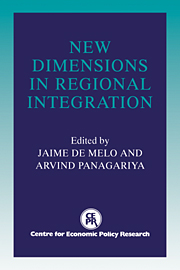Book contents
- Frontmatter
- Contents
- List of figures
- List of tables
- Preface
- Foreword
- Acknowledgements
- List of conference participants
- PART ONE SYSTEMIC ISSUES
- PART TWO COUNTRY ISSUES
- 6 The new regionalism: a country perspective
- Discussion
- 7 The European Community: a case of successful integration?
- Discussion
- 8 Regional integration in Sub-Saharan Africa: past experience and future prospects
- Discussion
- 9 Latin America's integration and the multilateral trading system
- Discussion
- 10 Regional integration in Eastern Europe: prospects for integration within the region and with the European Community
- Discussion
- 11 Regional trade arrangements in North America: CUSTA and NAFTA
- Discussion
- 12 Trading blocs and East Asia
- Discussion
- 13 Prospects for regional integration in the Middle East
- Discussion
- Round Table Discussion
- Index
9 - Latin America's integration and the multilateral trading system
Published online by Cambridge University Press: 04 May 2010
- Frontmatter
- Contents
- List of figures
- List of tables
- Preface
- Foreword
- Acknowledgements
- List of conference participants
- PART ONE SYSTEMIC ISSUES
- PART TWO COUNTRY ISSUES
- 6 The new regionalism: a country perspective
- Discussion
- 7 The European Community: a case of successful integration?
- Discussion
- 8 Regional integration in Sub-Saharan Africa: past experience and future prospects
- Discussion
- 9 Latin America's integration and the multilateral trading system
- Discussion
- 10 Regional integration in Eastern Europe: prospects for integration within the region and with the European Community
- Discussion
- 11 Regional trade arrangements in North America: CUSTA and NAFTA
- Discussion
- 12 Trading blocs and East Asia
- Discussion
- 13 Prospects for regional integration in the Middle East
- Discussion
- Round Table Discussion
- Index
Summary
Introduction
This chapter addresses three questions on Latin America's integration efforts: What are the major characteristics of the ongoing integration schemes, and how can they be improved? What integration strategy would provide the greatest economic gains to the region? How can Latin America's integration help to improve the multilateral trading system? Our main conclusion is that since the loss to Latin America from a breakdown of the multilateral trading system will not be compensated by preferential reductions of trade barriers, integration proposals should be liberal and used to reinvigorate the currently strained multilateral trading system. We believe that the broad characteristics of trading arrangements which may enhance economic welfare are that barriers to intratrade should be dismantled and that tariffs and non-tariff barriers (NTBs) with third countries should be significantly reduced; they can be acceded by any country; they support unilateral liberalisation measures by member countries; they avoid using harmonisation of policies such as standards and rules of origin to provide protection; they restrict the group of policies – such as anti-dumping – that have undermined the multilateral trading system; and they support the multilateral trading negotiations (MTNs).
Section 2's main purpose is to present a critical review of Latin America's past integration strategy. Section 3 analyses the effects of Latin America's recent unilateral reforms and the role of the multilateral trading system, and discusses their impact on the integration process. Section 4 analyses the current integration schemes, and addresses the question as to how their potential net benefits can be improved.
- Type
- Chapter
- Information
- New Dimensions in Regional Integration , pp. 278 - 313Publisher: Cambridge University PressPrint publication year: 1993
- 10
- Cited by



